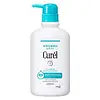What's inside
What's inside
 Key Ingredients
Key Ingredients

 Benefits
Benefits

 Concerns
Concerns

 Ingredients Side-by-side
Ingredients Side-by-side

Water
Skin ConditioningGlycerin
HumectantIsopropyl Palmitate
EmollientCetyl Ethylhexanoate
EmollientGlyceryl Stearate Se
EmulsifyingCetyl Alcohol
EmollientParfum
MaskingDimethicone
EmollientButyrospermum Parkii Butter
Skin ConditioningButyrospermum Parkii Oil
EmollientPetrolatum
EmollientParaffinum Liquidum
EmollientCarbomer
Emulsion StabilisingCaprylyl Glycol
EmollientHexylene Glycol
EmulsifyingPhenoxyethanol
PreservativePalmitic Acid
EmollientStearic Acid
CleansingMyristic Acid
CleansingDisodium EDTA
Sodium Hydroxide
BufferingTocopheryl Acetate
AntioxidantCitric Acid
BufferingWater, Glycerin, Isopropyl Palmitate, Cetyl Ethylhexanoate, Glyceryl Stearate Se, Cetyl Alcohol, Parfum, Dimethicone, Butyrospermum Parkii Butter, Butyrospermum Parkii Oil, Petrolatum, Paraffinum Liquidum, Carbomer, Caprylyl Glycol, Hexylene Glycol, Phenoxyethanol, Palmitic Acid, Stearic Acid, Myristic Acid, Disodium EDTA, Sodium Hydroxide, Tocopheryl Acetate, Citric Acid
Dipotassium Glycyrrhizate
HumectantWater
Skin ConditioningAmmonium Lauryl Sulfate
CleansingC9-11 Alkyl Glucoside
CleansingLauryl Hydroxysultaine
CleansingPPG-7 Lauryl Ether
EmollientPPG-10 Lauryl Ether
Alcohol Denat.
AntimicrobialSodium Hydroxide
BufferingZinc Chloride
AntimicrobialDiallyldimethyl Ammonium Chloride
Methylglucoside Phosphate
Skin ConditioningEucalyptus Maculata Extract
Skin ConditioningMalic Acid
BufferingAcrylamide
Glyceryl Ethylhexanoate
EmollientCetyl Pyrrolidonylmethyl Dimonium Chloride
Butylene Glycol
HumectantBenzyl Benzoate
AntimicrobialDipotassium Glycyrrhizate, Water, Ammonium Lauryl Sulfate, C9-11 Alkyl Glucoside, Lauryl Hydroxysultaine, PPG-7 Lauryl Ether, PPG-10 Lauryl Ether, Alcohol Denat., Sodium Hydroxide, Zinc Chloride, Diallyldimethyl Ammonium Chloride, Methylglucoside Phosphate, Eucalyptus Maculata Extract, Malic Acid, Acrylamide, Glyceryl Ethylhexanoate, Cetyl Pyrrolidonylmethyl Dimonium Chloride, Butylene Glycol, Benzyl Benzoate
 Reviews
Reviews

Alternatives
Ingredients Explained
These ingredients are found in both products.
Ingredients higher up in an ingredient list are typically present in a larger amount.
Sodium Hydroxide is also known as lye or caustic soda. It is used to adjust the pH of products; many ingredients require a specific pH to be effective.
In small amounts, sodium hydroxide is considered safe to use. However, large amounts may cause chemical burns due to its high alkaline.
Your skin has a natural pH and acid mantle. This acid mantle helps prevent harmful bacteria from breaking through. The acid mantle also helps keep your skin hydrated.
"Alkaline" refers to a high pH level. A low pH level would be considered acidic.
Learn more about Sodium HydroxideWater. It's the most common cosmetic ingredient of all. You'll usually see it at the top of ingredient lists, meaning that it makes up the largest part of the product.
So why is it so popular? Water most often acts as a solvent - this means that it helps dissolve other ingredients into the formulation.
You'll also recognize water as that liquid we all need to stay alive. If you see this, drink a glass of water. Stay hydrated!
Learn more about Water